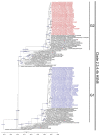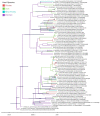Multiple Reassortants of H5N8 Clade 2.3.4.4b Highly Pathogenic Avian Influenza Viruses Detected in South Korea during the Winter of 2020-2021
- PMID: 33809549
- PMCID: PMC8001867
- DOI: 10.3390/v13030490
Multiple Reassortants of H5N8 Clade 2.3.4.4b Highly Pathogenic Avian Influenza Viruses Detected in South Korea during the Winter of 2020-2021
Abstract
During October 2020-January 2021, we isolated a total of 67 highly pathogenic avian influenza (HPAI) H5N8 viruses from wild birds and outbreaks in poultry in South Korea. We sequenced the isolates and performed phylogenetic analysis of complete genome sequences to determine the origin, evolution, and spread patterns of these viruses. Phylogenetic analysis of the hemagglutinin (HA) gene showed that all the isolates belong to H5 clade 2.3.4.4 subgroup B (2.3.4.4b) and form two distinct genetic clusters, G1 and G2. The cluster G1 was closely related to the 2.3.4.4b H5N8 HPAI viruses detected in Europe in early 2020, while the cluster G2 had a close genetic relationship with the 2.3.4.4b H5N8 viruses that circulated in Europe in late 2020. A total of seven distinct genotypes were identified, including five novel reassortants carrying internal genes of low pathogenic avian influenza viruses. Our Bayesian discrete trait phylodynamic analysis between host types suggests that the viruses initially disseminated from migratory waterfowl to domestic duck farms in South Korea. Subsequently, domestic duck farms most likely contributed to the transmission of HPAI viruses to chicken and minor poultry farms, highlighting the need for enhanced, high levels of biosecurity measures at domestic duck farms to effectively prevent the introduction and spread of HPAI.
Keywords: H5N8; domestic duck; highly pathogenic avian influenza virus; reassortant; transmission; wild bird.
Conflict of interest statement
The authors declare no conflict of interest.
Figures





References
Publication types
MeSH terms
LinkOut - more resources
Full Text Sources
Other Literature Sources
Medical

